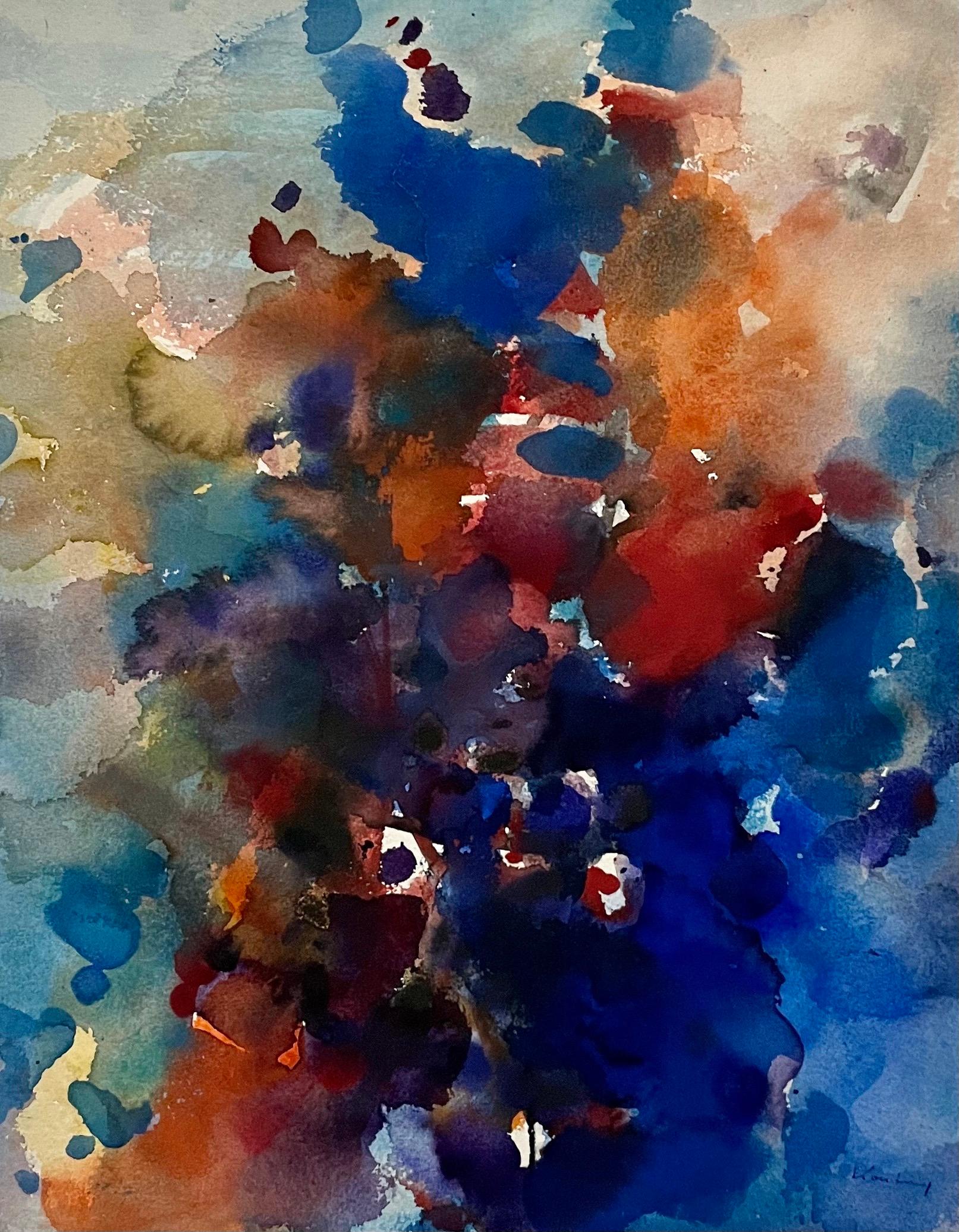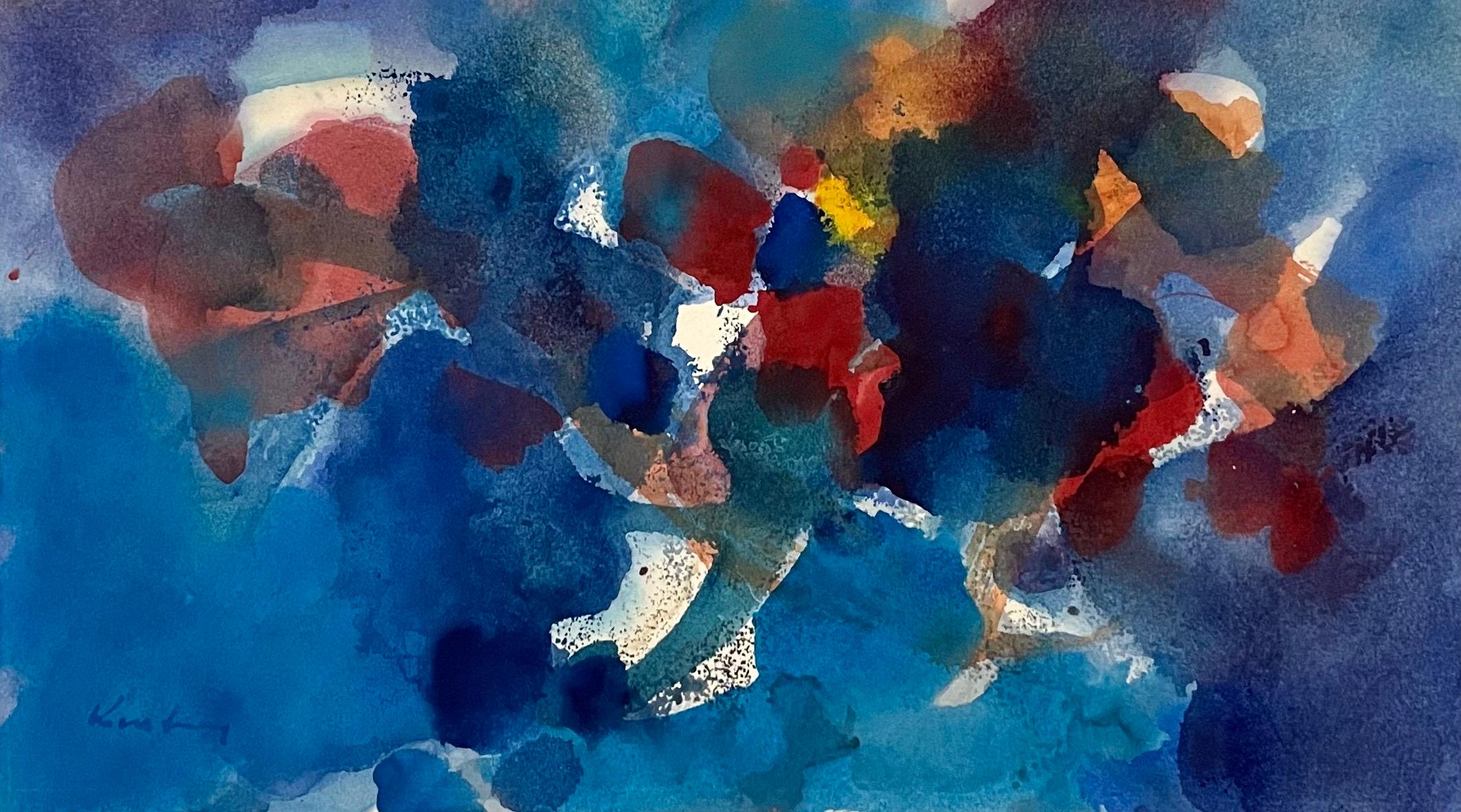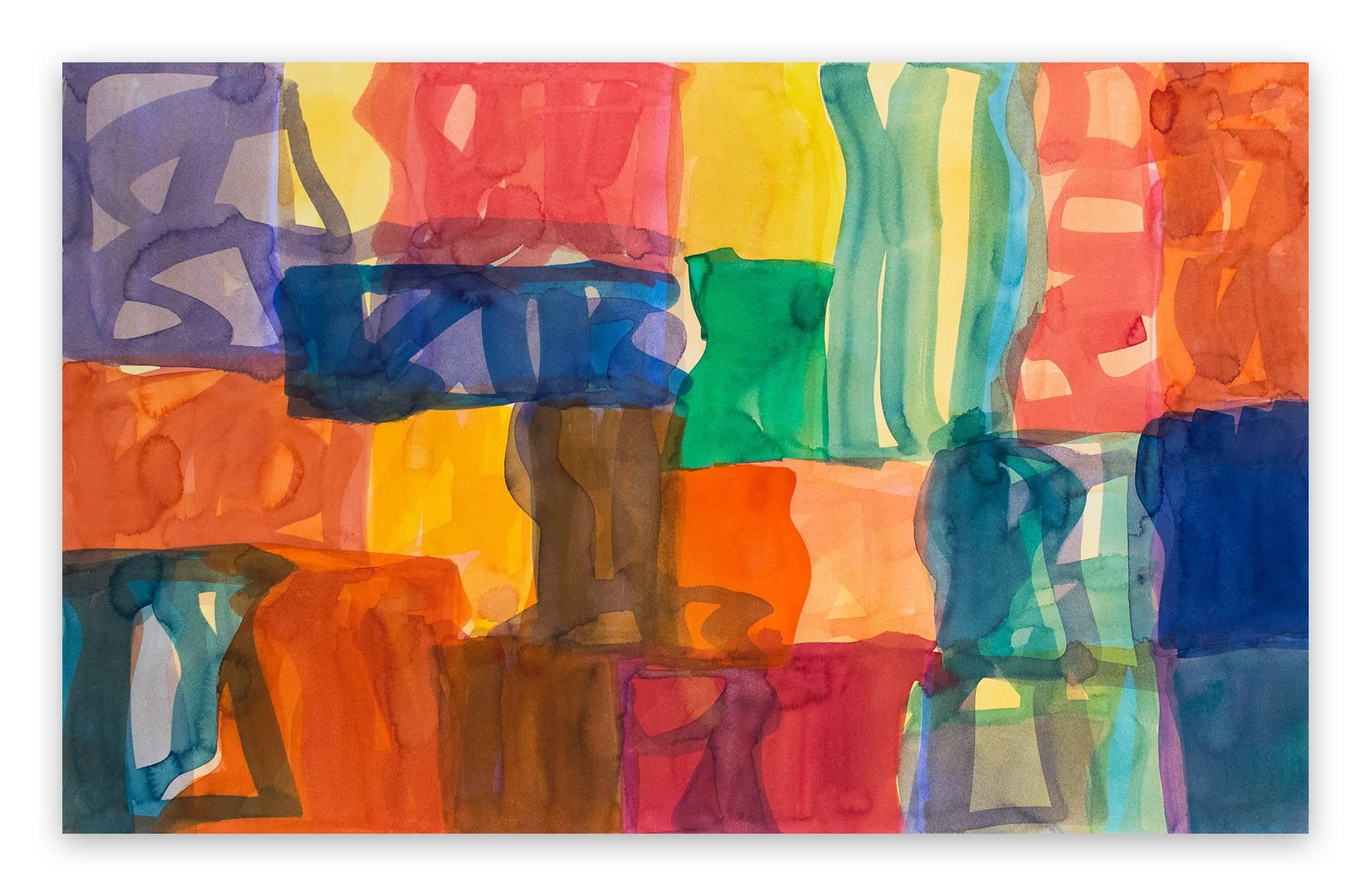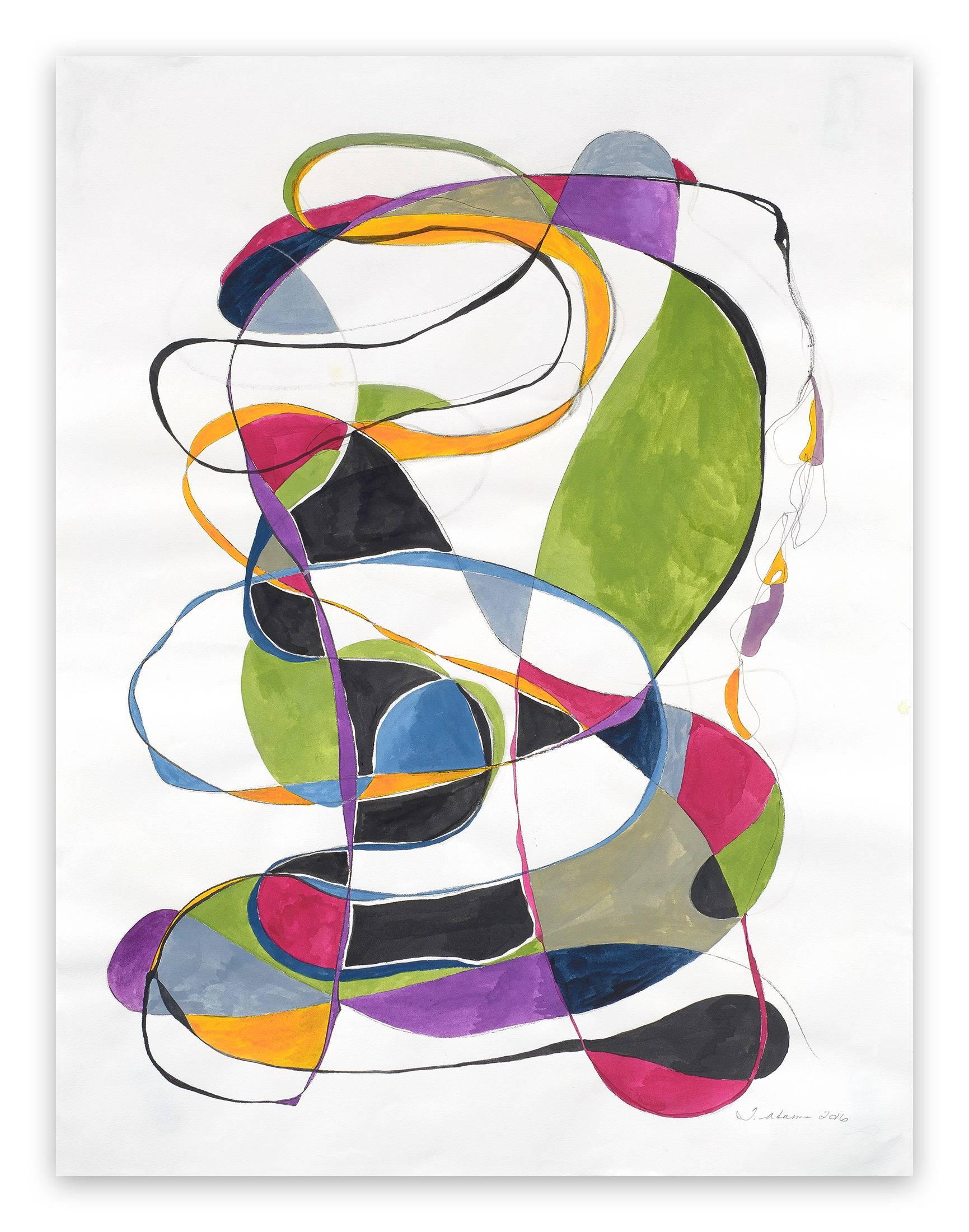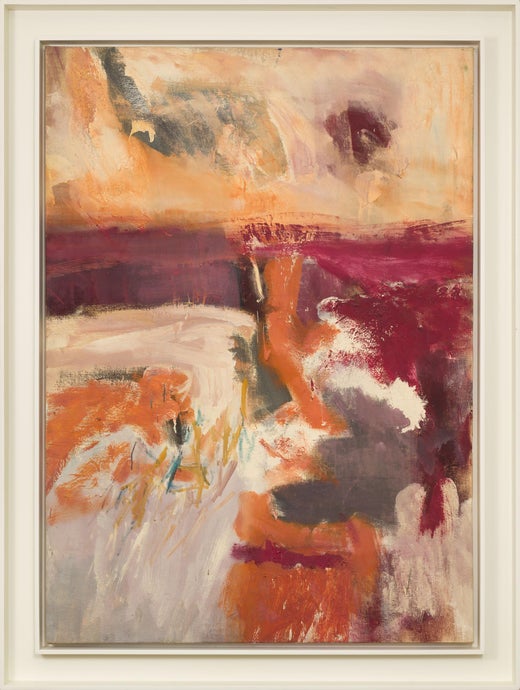Items Similar to "Inherent Light Series IX, " Alan Fenton, Abstract Expressionism, Black Stripes
Want more images or videos?
Request additional images or videos from the seller
1 of 6
Alan Fenton"Inherent Light Series IX, " Alan Fenton, Abstract Expressionism, Black Stripes1977
1977
About the Item
Alan Fenton (1927 - 2000)
Inherent Light Series IX, 1977
Watercolor on paper
23 x 17 inches
Signed and dated lower right; titled lower left
Fenton's quiet and contemplative nonobjective paintings and drawings were widely recognized for their demanding yet understated means of revealing a serious and sober essence. He identified greatly with Mark Rothko, a friend, as well as Adolph Gottlieb and Jack Tworkov, with whom he had studied privately. Fenton painted in New York City in the late 50's as the explosion of Abstract Expressionism turned into a rebellion against gestural, emotional painting.
More concerned about his art than his posture, he expanded upon a tradition in painting with influences as diverse as Whistler and Turner as well as Ad Reinhardt and Joseph Albers.
Alan Fenton was born in Cleveland in 1927, studied at the Cleveland School of Art, The Arts Students League, The New School, and at NYU, earning his BFA at Pratt Institute, where he later taught painting for many years. At seventeen, Fenton served in the Merchant Marines where he began a career as a professional boxer, a skill he had honed on the streets.
He moved successfully through the graphic design business en route to becoming a painter in New York at the height of the art revolution of the fifties and sixties. Fenton enjoyed success with his subtle washes and pencil drawings as well as large abstract canvases in acrylic, landing one-man shows at the prestigious Pace Gallery in New York, The New York Cultural Center Museum, The Barbara Fielder Gallery in Washington, et al.
In his introduction to Fenton's exhibition catalogue for his one-man show at the Phillips Collection in Washington, Vincent Melzac wrote, ''Fenton is his own man, producing work that is uniquely his. In his work one feels that Fenton is testing the accepted and pushing for a newer and richer visual experience.''
In the late 60's he turned his artistic vision and business savvy towards developing creative environments where ''good and beautiful people'' could live and work together. His first endeavor was to turn the Tiffany Glass Building on lower Park Avenue into an artistic community where notable photographers, painters, and filmmakers moved in, setting the stage for a modern, hip, yet warm and friendly working space for the community which he had nurtured. He later developed the first live/work loft in Cleveland, where Fenton resided during his last years.
Fenton said about his own work, ''All that happens in my work is natural and human, hard and soft, large and small, heaven and earth. All this with the image of man, (my glow) forms a system to attain the sublime. All of these paradoxes form a triad that is the way of everything. The line is the 'hard', the formless form and the imageless image is the 'soft'. They are inseparable, one cannot exist without the other.''
Fenton's work resides at The Hirschhorn Museum of Art, the Smithsonian American Art Museum, the Phillips Collection, the North Carolina Museum of Art, and The Cleveland Museum of Art, and countless others as well as in private collections.
- Creator:Alan Fenton (1927 - 2000, American)
- Creation Year:1977
- Dimensions:Height: 31 in (78.74 cm)Width: 25 in (63.5 cm)
- Medium:
- Movement & Style:
- Period:
- Condition:
- Gallery Location:New York, NY
- Reference Number:1stDibs: LU1841210236672
Fenton's quiet and contemplative nonobjective paintings and drawings were widely recognized for their demanding yet understated means of revealing a serious and sober essence. He identified greatly with Mark Rothko, a friend, as well as Adolph Gottlieb and Jack Tworkov, with whom he had studied privately. Fenton painted in New York City in the late 50's as the explosion of Abstract Expressionism turned into a rebellion against gestural, emotional painting. More concerned about his art than his posture, he expanded upon a tradition in painting with influences as diverse as Whistler and Turner as well as Ad Reinhardt and Joseph Albers. Alan Fenton was born in Cleveland in 1927, studied at the Cleveland School of Art, The Arts Students League, The New School, and at NYU, earning his BFA at Pratt Institute, where he later taught painting for many years. At seventeen, Fenton served in the Merchant Marines where he began a career as a professional boxer, a skill he had honed on the streets. He moved successfully through the graphic design business en route to becoming a painter in New York at the height of the art revolution of the fifties and sixties. Fenton enjoyed success with his subtle washes and pencil drawings as well as large abstract canvases in acrylic, landing one-man shows at the prestigious Pace Gallery in New York, The New York Cultural Center Museum, The Barbara Fielder Gallery in Washington, et al. In his introduction to Fenton's exhibition catalogue for his one-man show at the Phillips Collection in Washington, Vincent Melzac wrote, ''Fenton is his own man, producing work that is uniquely his...in his work one feels that Fenton is testing the accepted and pushing for a newer and richer visual experience.'' In the late 60's he turned his artistic vision and business savvy towards developing creative environments where ''good and beautiful people'' could live and work together. His first endeavor was to turn the Tiffany Glass Building on lower Park Avenue into an artistic community where notable photographers, painters, and filmmakers moved in, setting the stage for a modern, hip, yet warm and friendly working space for the community which he had nurtured. He later developed the first live/work loft in Cleveland, where Fenton resided during his last years. Fenton said about his own work, ''All that happens in my work is natural and human, hard and soft, large and small, heaven and earth. All this with the image of man, (my glow) forms a system to attain the sublime. All of these paradoxes form a triad that is the way of everything. The line is the 'hard', the formless form and the imageless image is the 'soft'. They are inseparable, one cannot exist without the other.'' Fenton's work resides at The Hirschhorn Museum of Art, the Smithsonian American Art Museum, the Phillips Collection, the North Carolina Museum of Art, and The Cleveland Museum of Art, and countless others as well as in private collections.
About the Seller
5.0
Platinum Seller
These expertly vetted sellers are 1stDibs' most experienced sellers and are rated highest by our customers.
Established in 2021
1stDibs seller since 2022
62 sales on 1stDibs
Typical response time: 1 hour
- ShippingRetrieving quote...Ships From: Larchmont, NY
- Return PolicyA return for this item may be initiated within 3 days of delivery.
More From This SellerView All
- "Rembrandt Later Danae, " Alan Fenton, Abstract ExpressionismLocated in New York, NYAlan Fenton (1927 - 2000) Rembrandt Later Danae, 1975 Watercolor on paper 23 x 17 inches Signed and dated lower right; titled lower left Fenton's quiet an...Category
1970s Abstract Expressionist Abstract Paintings
MaterialsPaper, Watercolor, Gouache
- "Tiny Travelers, " Alan Fenton, Abstract Expressionism, New York School, StripesLocated in New York, NYAlan Fenton (1927 - 2000) Tiny Travelers II, 1975 Watercolor on paper 23 x 17 inches Signed and dated lower right; titled lower left Fenton's quiet and co...Category
1970s Abstract Expressionist Abstract Paintings
MaterialsPaper, Watercolor
- "Untitled, " Alan Fenton, Abstract ExpressionismLocated in New York, NYAlan Fenton (1927 - 2000) Untitled, 1965 Charcoal and graphite on paper 23 x 17 inches Signed and dated lower right Fenton's quiet and contemplative nonob...Category
1960s Abstract Expressionist Abstract Paintings
MaterialsPaper, Charcoal, Graphite
- "Repetition" Chryssa, Greek Female Artist, Abstract, Neon Light Art StudyBy Chryssa Vardea-MavromichaliLocated in New York, NYChryssa Repetition Signed lower right; titled on the reverse Gouache, watercolor, charcoal, and graphite on paper 15 x 11 inches Born and educated in Athens, Greece, Vardea Chryssa, known professionally as Chryssa, became a U.S. citizen and earned a reputation for her sculptured assemblages utilizing light from neon, and plexiglas combined with mixed media pieces. One of her pieces, Untitled Light Sculpture (1980) is 22 feet long and is installed in the atrium of a building at 33 Monroe Street in Chicago. It was programmed electronically to create changing patterns of reflected light through 900 feet of neon tubing. Chryssa's sculptures with precision and definite form were a reaction against the prevalent Abstract Expressionism of the 1950s with its emphasis purely upon the artist's intent. In her work, the focus is on materials and the way they are shaped for specific use by craftsmen. She got her early education in Athens, and first studied to be a social worker. She was then sent by the Greek Ministry of Social Welfare to the Dodecanese Islands and later to the Ionian Sea island of Zante, whose population had suffered great loss from earthquakes. Disillusioned that monies were being provided to restore monasteries but not to help other earthquake victims, Chryssa changed her life's direction to become a painter. In Athens, she studied art with Anghelos Prokopion. Then she went to Paris, France, and studied briefly at the Academie Grande Chaumiere and associated with surrealists Andre Breton, Edgard Varese, and Max Ernst. In 1954, she moved to San Francisco, California for a year of study at the California School of Fine Arts, and there she first saw the work of Jackson Pollock, which had a freeing affect on her and inspired her to experiment with pure form. But later she reacted against action painting with her assemblage sculptures of controlled precision. In 1955, Chryssa settled in New York City, and became the first artist to incorporate neon light tubing and commercial signs into sculpture. It is asserted that her "mature work grew out of the Greek experience, before and after World War II, wedded to the raucous letters, signs, symbols, and lights of Time Square, New York City" (Heller 125). In fact, she was so taken with the lights of Times Square that she unsuccessfully tried to get a job as a sign maker but was prevented by labor union rules. However, one of the members gave her sign-making lessons in his shop. She first made Pop images such as depictions of automobile tires and cigarettes and in sculptures, utilized letters of the alphabet, ideas that predated similar images by Jasper Johns and Andy Warhol. Her first major work of interwoven light and letters was Times Square Sky of 1962, but she was dissatisfied because she thought the piece was too crowded. To create a sense of breathing, she inserted neon light, and for the first time, this material became an art medium. From that time, she was prolific and created many variations based on the letters W and A. For her, a primary motivating factor was remaining cool or mentally collected amidst the onslaught of bombarding information and to process it through her creations in new ways so that nothing was repeated. She set up her own work place...Category
Late 20th Century Abstract Abstract Paintings
MaterialsGouache, Graphite, Paper, Charcoal, Watercolor
- "Untitled, " Thiago Rocha Pitta, Brazilian Contemporary Grey WatercolorLocated in New York, NYThiago Rocha Pitta Untitled, 2006 Watercolor on paper 30 x 23 inches Brazil-based artist Thiago Rocha Pitta’s (b. 1980) temporal and sensitive body of work depicts interventions wit...Category
Early 2000s Contemporary Abstract Drawings and Watercolors
MaterialsPaper, Watercolor
- "Untitled, " Thiago Rocha Pitta, Contemporary Grey WatercolorLocated in New York, NYThiago Rocha Pitta Untitled, 2006 Watercolor on paper 30 x 23 inches Brazil-based artist Thiago Rocha Pitta’s (b. 1980) temporal and sensitive body of work depicts interventions wit...Category
Early 2000s Contemporary Abstract Drawings and Watercolors
MaterialsPaper, Watercolor
You May Also Like
- Modernist Abstract Expressionist Watercolor Painting Bauhaus Weimar ArtistBy Pawel KontnyLocated in Surfside, FLAbstract watercolor composition bearing the influence of the earlier color-block compositions of Paul Klee and Abstract Expressionist master Sam Francis. Pawel August Kontny, (Polish-German-American artist) He was born in Laurahuette, Poland, in 1923, the son of a wealthy pastry shop owner. In 1939 he began studying architecture in Breslau where he was introduced to the European masters and to the work of some of the German Expressionists, soon afterward banned as "degenerate artists" and removed from museums throughout Germany by the Nazi regime. His studies were interrupted by World War II. Drafted into the German army, traveling in many countries as a soldier, he sketched various landscapes but in 1945, he was captured and held as a prisoner of war in Italy. After the war, he studied at the Union of Nuremberg Architects to help design buildings to replace ones destroyed in the war. He recorded his impressions of the local population and the landscapes through his watercolors and drawings. Pawel Kontny thereafter moved to Nuremberg, Germany, becoming a member of the Union of Nuremberg Architects and helping to rebuild the city's historic center. He soon decided to concentrate on his professional art career. He married Irmgard Laurer, a dancer with the Nuremberg Opera. Pavel Kontny 's career as an artist was launched with his participation in an all German exhibition, held at the Dusseldorf Museum in 1952. He held one-man shows in Germany, Switzerland and the United States. During his trip to the United States in 1960, Kontny became instantly enamored with Colorado, and decided to relocate to Cherry Hills with his wife and two children. He quickly established himself in the local art community, being affiliated for a time with Denver Art Galleries and Saks Galleries. His subject matter became the Southwest. During this time he received the Prestigious Gold Medal of the Art Academy of Rome. His extensive travel provided material for the paintings he did using his hallmark marble dust technique. he also worked equally in pastel, watercolor, charcoal and pencil-and-ink. in a style which merged abstraction and realist styles, influenced by Abstract Expressionist painting and South Western American landscapes. In the early 1960s he was one of only a few European-born professional artists in the state, a select group that included Herbert Bayer (1900-1985), a member of the prewar Bauhaus in Weimar and Dessau, Germany, and Roland Detre (1903-2001), a Hungarian modernist painter. As a Denver, Colorado resident, Pavel Kontny exhibited at galleries and museums throughout the United States, Germany and Japan. There, he was inspired by frequent trips to Native American pueblos in the Southwest, as well as by the study of the Plains Indians of Montana and Wyoming. Over the years Kontny had a number of students and generously helped young artist by hosting exhibitions at his Cherry Hills home. For many years he generously donated his paintings to support charitable causes in Denver. Influences during his European years included German pastelist C.O. Muller, German Informel painter Karl Dahmen and Swiss artist, Hans Erni. In the early 1950s his painting style showed the influence of the Die Brücke (The Bridge), a group of German expressionist artists formed in Dresden in 1905 who had a major impact on the evolution of modern art in the twentieth century in Germany. By the middle of the decade his style incorporated more referential abstraction and total abstraction, resulting in part from his study of Hans Hartung, a German artist based in Paris who exhibited his gestural abstract work in Germany. The American moon landing in 1969 inspired Paul Kontny...Category
20th Century Abstract Expressionist Abstract Drawings and Watercolors
MaterialsWatercolor, Archival Paper
- Modernist Abstract Expressionist Watercolor Painting Bauhaus Weimar Pawel KontnyBy Pawel KontnyLocated in Surfside, FLAbstract watercolor composition bearing the influence of the earlier color-block compositions of Paul Klee. Pawel August Kontny, (Polish-German-American artist) He was born in Laurahuette, Poland, in 1923, the son of a wealthy pastry shop owner. In 1939 he began studying architecture in Breslau where he was introduced to the European masters and to the work of some of the German Expressionists, soon afterward banned as "degenerate artists" and removed from museums throughout Germany by the Nazi regime. His studies were interrupted by World War II. Drafted into the German army, traveling in many countries as a soldier, he sketched various landscapes but in 1945, he was captured and held as a prisoner of war in Italy. After the war, he studied at the Union of Nuremberg Architects to help design buildings to replace ones destroyed in the war. He recorded his impressions of the local population and the landscapes through his watercolors and drawings. Pawel Kontny thereafter moved to Nuremberg, Germany, becoming a member of the Union of Nuremberg Architects and helping to rebuild the city's historic center. He soon decided to concentrate on his professional art career. He married Irmgard Laurer, a dancer with the Nuremberg Opera. Pavel Kontny 's career as an artist was launched with his participation in an all German exhibition, held at the Dusseldorf Museum in 1952. He held one-man shows in Germany, Switzerland and the United States. During his trip to the United States in 1960, Kontny became instantly enamored with Colorado, and decided to relocate to Cherry Hills with his wife and two children. He quickly established himself in the local art community, being affiliated for a time with Denver Art Galleries and Saks Galleries. His subject matter became the Southwest. During this time he received the Prestigious Gold Medal of the Art Academy of Rome. His extensive travel provided material for the paintings he did using his hallmark marble dust technique. he also worked equally in pastel, watercolor, charcoal and pencil-and-ink. in a style which merged abstraction and realist styles, influenced by Abstract Expressionist painting and South Western American landscapes. This one is influenced by California Abstract Expressionist artist Sam Francis. In the early 1960s he was one of only a few European-born professional artists in the state, a select group that included Herbert Bayer (1900-1985), a member of the prewar Bauhaus in Weimar and Dessau, Germany, and Roland Detre (1903-2001), a Hungarian modernist painter. As a Denver, Colorado resident, Pavel Kontny exhibited at galleries and museums throughout the United States, Germany and Japan. There, he was inspired by frequent trips to Native American pueblos in the Southwest, as well as by the study of the Plains Indians of Montana and Wyoming. Over the years Kontny had a number of students and generously helped young artist by hosting exhibitions at his Cherry Hills home. For many years he generously donated his paintings to support charitable causes in Denver. Influences during his European years included German pastelist C.O. Muller, German Informel painter Karl Dahmen and Swiss artist, Hans Erni. In the early 1950s his painting style showed the influence of the Die Brücke (The Bridge), a group of German expressionist artists formed in Dresden in 1905 who had a major impact on the evolution of modern art in the twentieth century in Germany. By the middle of the decade his style incorporated more referential abstraction and total abstraction, resulting in part from his study of Hans Hartung, a German artist based in Paris who exhibited his gestural abstract work in Germany. The American moon landing in 1969 inspired Paul Kontny...Category
20th Century Abstract Expressionist Abstract Drawings and Watercolors
MaterialsWatercolor, Archival Paper
- Balancing act 4By Tracey AdamsLocated in London, GBGouache, graphite and ink on Rives paper. Unframed. Balancing Act 4 is part of a series of works on paper started in 2016. They are created in the evenings and aptly named after busy days of teaching and other responsibilities. The artist establishes parameters involving the use of a particular palette, certain mark-making gestures and amount of time spent on each drawing. This work incorporates graphite, ink, and gouache, and is a combination of intuition-based and planned execution. Tracey Adams is an American abstract painter and printmaker. Her artworks reflect a strong interest in musical patterns, rhythms, lyrical compositional elements and what she calls a sense of performance. She lives and works in Carmel, California. Work by Adams is part of the permanent collections of several museums, including the Bakersfield Art Museum, the Monterey Museum of Art, the Fresno Art Museum, the Tucson Art...Category
2010s Abstract Expressionist Abstract Paintings
MaterialsPaper, Ink, Gouache, Graphite
- Ambassade 47 (Abstract Expressionism painting)By Melissa MeyerLocated in London, GBWatercolor on hot press paper - Unframed This work is part of the watercolour series titled Ambassade which was named after a visit at Meyer's favorite hotel in Amsterdam. Melissa...Category
Early 2000s Abstract Expressionist Abstract Drawings and Watercolors
MaterialsPaper, Watercolor
- Yaddo B (Abstract Expressionism painting)By Melissa MeyerLocated in London, GBYaddo B (Abstract Expressionism painting) Watercolour on 100% rag hot press paper. Unframed. Melissa Meyer has created a diverse oeuvre that includes oil paintings, drawings, water...Category
Early 2000s Abstract Expressionist Abstract Paintings
MaterialsWatercolor, Rag Paper
- Balancing act 2 (Abstract Painting)By Tracey AdamsLocated in London, GBBalancing act 2 (Abstract Painting) Gouache, graphite and ink on Rives paper. Unframed. Balancing Act 2 is part of a series of works on paper started in 2016. They are created in the evenings and aptly named after busy days of teaching and other responsibilities. The artist establishes parameters involving the use of a particular palette, certain mark-making gestures and amount of time spent on each drawing. This work incorporates graphite, ink, and gouache, and is a combination of intuition-based and planned execution. Tracey Adams is an American abstract painter and printmaker. Her artworks reflect a strong interest in musical patterns, rhythms, lyrical compositional elements and what she calls a sense of performance. She lives and works in Carmel, California. Work by Adams is part of the permanent collections of several museums, including the Bakersfield Art Museum, the Monterey Museum of Art, the Fresno Art Museum, the Tucson Art...Category
2010s Abstract Expressionist Abstract Paintings
MaterialsPaper, Ink, Gouache, Graphite
Recently Viewed
View AllMore Ways To Browse
Abstract Art Series
Black Stripes
Black Stripe
Line Series Painting
Used Stage Light
Abstract Expressionism Framed
Abstract Expressionism Art Framed
Student Light
Framed Abstract Expressionism Paintings
Small Framed Art Series
Black Abstract Expressionism
Abstract Expressionism On Paper
Expressionism City
Phillips Collection
The Phillips Collection
50s Abstract
Abstract Stripes
Modern Art Stripes
